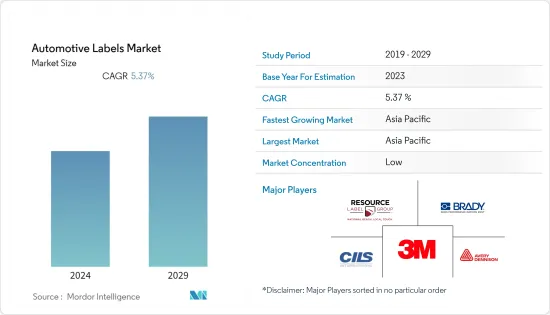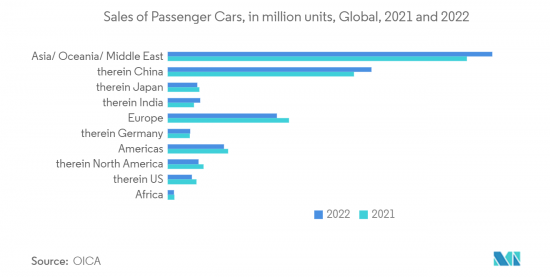 |
市場調查報告書
商品編碼
1405345
汽車標籤:市場佔有率分析、產業趨勢/統計、成長預測,2024-2029Automotive Labels - Market Share Analysis, Industry Trends & Statistics, Growth Forecasts 2024 - 2029 |
||||||
※ 本網頁內容可能與最新版本有所差異。詳細情況請與我們聯繫。
上年度汽車標籤市場規模為74.1億美元,預計在預測期內將達到101.1億美元,複合年成長率為5.37%。

主要亮點
- 汽車產業對車輛的需求不斷成長,以及對用於汽車零件識別、資訊和安全的無線射頻識別 (RFID) 和條碼等標籤的需求預計將推動市場發展。由於所有最終用戶行業的包裝和標籤市場的成長,汽車標籤行業正在顯著擴張。
- 汽車標籤通常由徽章和標籤組成,例如條碼、報價和車輛識別號碼 (VIN) 標籤,顯示零件資訊、公司名稱或標誌、價格、技術資訊和其他重要詳細資訊。預計推動市場成長的其他因素包括對 RFID 和條碼等智慧標籤的需求不斷增加,對環保標籤製造方法的需求不斷增加等。
- 汽車標籤在小客車中的使用不斷增加是推動市場成長的主要因素之一。此外,汽車製造設備投資的增加和小客車產量的增加是拉動汽車標籤市場需求的主要因素。由於幾乎每個行業的技術發展,汽車標籤市場也在不斷擴大。對自動駕駛平台產生的數百萬張照片和影片進行正確分類至關重要。
- 汽車行業有許多標籤要求,從清潔用品和汽車製造商到一級方程式賽車和大眾交通工具。該行業幾乎在汽車的每個區域都使用標籤,包括外裝和引擎。汽車標籤可用於該領域的啟動馬達、電纜、泵浦、馬達、引擎管理系統等。
- 隨著汽車標籤市場的不斷成長,全球對油墨成分的法令遵循也變得更加嚴格。因此,選擇與這些市場相容且與潛在設計油墨不同的成分對於配方設計師來說是一項複雜而艱鉅的挑戰。這加上各國生產成本的上升,預計將阻礙市場成長。
- 汽車標籤製造商在應對眼前的危機並尋找新的 COVID-19 後工作方式時,應保護其營運和供應鏈。但標籤是必需品供應鏈的一部分。此外,它也是傳遞資訊的重要工具。此外,汽車標籤市場領先於產業技術變革。自動駕駛平台會產生數十億張圖像和影片,必須以最高精度進行標記。
汽車標籤市場趨勢
條碼細分市場佔據主要市場佔有率佔有率
- 條碼標籤提供了一種快速儲存和搜尋資料的方法。條碼標籤以線條和數字的形式包含公司和產品詳細資訊。條碼標籤還可用於管理庫存並透過提供可追溯性來減少召回負擔。汽車標籤條碼常見於引擎、車門和儀表板等零件上。
- 2D條碼是汽車零件標籤最常用的條碼類型之一。標籤在汽車零件製造商的供應鏈中發揮重要作用。它確保產品的準確交付,提供關鍵的條碼和其他資訊,並加速貨物的流動。從客戶特定需求和新興市場賣家品牌要求到進出口控制和海關審核,標籤是勞力密集且成本高昂的。
- 另一方面,3D 掃描器可產生條碼的 3D 掃描。此掃描可以從任何方向讀取。 3D 條碼掃描器通常用於汽車組裝和製造等工業應用。
- 多家製造商提供各種汽車條碼標籤。例如,Metalcraft 生產多種用途的塑膠條碼標籤。可用於擋風玻璃、電纜、電線、儀表板等。我們還有砸道機標籤、金屬化標籤等等。
- 汽車零件和汽車庫存標籤在汽車和汽車零件的生產中非常重要。汽車製造商使用條碼追蹤倉庫中的產品並檢查第三方物流(3PL) 供應商的庫存。他們還使用條碼(帶有印刷條碼)來識別具有各種其他資訊(例如序號、日期和型號)的零件。
- 條碼印表機和掃描器可以列印這些條碼並建立要套用至產品的標籤。這有助於追蹤庫存並最大限度地減少錯誤或丟失重要資訊的風險。據OICA稱,今年輕型汽車銷量預計將成長4.73%。總體而言,汽車行業的成長預計將有助於市場成長。

亞太地區預計將主導市場
- 亞太地區佔據主要市場佔有率,預計在預測期內將成長最快。艾利丹尼森等公司正在增加該地區新興企業的數量,以發展標籤和包裝行業並提高創新能力,這是推動市場成長的關鍵因素。
- 汽車售後服務市場的成長得益於多種因素,包括汽車產銷量的增加以及中國汽車零件產業的擴張。此外,由於以客戶為中心的客製化和二手車市場的增加,預計引擎售後服務市場在預測期內將出現強勁成長。在售後服務領域,標籤用於更換零件、提供維護和維修服務、確保安全、遵守法律規章。隨著市場的擴大,對引擎標籤和其他汽車標籤的需求預計也會增加。
- 印度汽車工業在宏觀經濟擴張和技術發展中發揮重要作用,成為衡量經濟實力的良好指標。在印度,中產階級不斷壯大,人口年輕化,兩輪車市場在保有量方面佔據主導地位。希望開拓區域市場的公司的興趣增加也支持了該行業的成長。結果,生產的汽車數量不斷增加。隨著汽車產業的持續成長,對包括標籤在內的汽車零件的需求預計也會增加。
- 日本政府承認無線射頻識別(RFID)是一項得到大量財政投資支持的創新技術,日本強大的生產基地將在未來幾年的RFID應用中主導作用。我們保證這一點。 RFID 技術的重大進步可以在政府支持的基礎上實現。這可能會導致更先進、更有效的 RFID 適合在汽車領域使用。
- 根據日本汽車工業協會的數據,2022 年日本汽車製造商在日本境外的生產設施生產了約 1,696 萬輛汽車,高於去年的 1,646 萬輛。將生產擴大到日本以外地區是這家日本汽車製造商全球擴大策略的體現。隨著汽車製造商在海外市場建立更強大的影響力,他們可能需要專門的標籤來適應不同地區和語言的獨特要求,進一步推動汽車標籤市場的需求。
汽車標籤產業概況
由於 3M 公司、艾利丹尼森公司、Resource Label Group 和 HB Fuller 公司等幾家大公司的存在,該市場呈現碎片化。以大型企業的參與為特徵的不斷變化的行業形勢正在加劇努力捕捉新機會的公司之間的競爭。同時,中小企業也處於成長軌道,並希望利用市場巨大的成長潛力。
其他福利:
- Excel 格式的市場預測 (ME) 表
- 3 個月分析師支持
目錄
第1章簡介
- 研究假設和市場定義
- 調查範圍
第2章調查方法
第3章執行摘要
第4章市場洞察
- 市場概況
- 產業吸引力-波特五力分析
- 供應商的議價能力
- 買方議價能力
- 新進入者的威脅
- 替代品的威脅
- 競爭公司之間的敵對關係
- 產業價值鏈分析
- COVID-19 對市場的影響
第5章市場動態
- 市場促進因素
- 汽車產業對 RFID 標籤的需求不斷成長
- 提高對標籤法律規章的遵守
- 市場抑制因素
- 小型製造商的製造成本增加
第6章市場區隔
- 透過識別技術
- 條碼
- QR 圖碼
- 無線射頻識別標籤
- 其他
- 按類型
- 品牌推廣
- 貨物追蹤
- 警告/安全
- 資產標籤
- 其他類型(輪胎標籤、耐候標籤)
- 按用途
- 室內使用
- 外裝使用
- 引擎應用
- 其他
- 按地區
- 北美洲
- 美國
- 加拿大
- 歐洲
- 英國
- 德國
- 法國
- 西班牙
- 其他歐洲國家
- 亞太地區
- 中國
- 印度
- 日本
- 其他亞太地區
- 拉丁美洲
- 中東/非洲
- 北美洲
第7章競爭形勢
- 公司簡介
- 3M Company
- Avery Dennison Corporation
- Resource Label Group LLC
- CILS International
- Brady Worldwide Inc.
- Asean Pack
- Polyonics Inc.
- Imagetek Labels
- Weber Packaging Solutions
- Advantage Label & Packaging Inc.
- Label-Aid Systems Inc.
- Clarion Safety Systems
第8章投資分析
第9章市場的未來

The automotive labels market was valued at USD 7.41 billion the previous year and is expected to register a CAGR of 5.37%, reaching USD 10.11 billion over the forecast period.
Key Highlights
- The increasing need for vehicles from the automotive industry and the requirement for labels like radio-frequency identification (RFID) and bar codes for the automotive part's identification, information, and safety are anticipated to drive the market. Due to the growth of the packaging and labeling markets across all end-user industries, the automotive labels industry is expanding significantly.
- Automotive labels typically consist of badging and labels, such as barcode, estimate, and vehicle identification number (VIN) labels, that display component information, a company's name and logo, price, technical information, and other important details. Additional factors anticipated to fuel market growth include the increased demand for smart labels, such as RFID and barcodes, and the rising demand for eco-friendly label production methods.
- The increasing utilization of automotive labels in passenger cars is one of the key factors driving the market growth. Moreover, the increasing investments in automobile manufacturing facilities and rising passenger car production are key factors fostering the market demand for automotive labels. The market for automotive labels market is also expanding due to technical developments occurring in almost every industry. It's important to properly categorize the millions of photos and videos that autonomous driving platforms produce.
- The automotive industry has many labeling requirements, from cleaning supplies and car producers to Formula 1 and public transportation. There are labels used in this industry in almost every area of a car, including the exterior and the engine. In this sector, automotive labeling may be used on starting motors, cables, pumps, motors, and engine management systems, among other things.
- As the market for automotive labels continues to grow, so too are the global compliance regulations for ink components. As a result, it has become complex and challenging for formulators to select ingredients to meet such a market and are different from the elements that could be a design ink. This and rising production costs in various countries are expected to hinder the market's growth.
- Automotive label manufacturers are expected to protect their operations and supply chain from meeting the impending crisis and finding new ways of working post-COVID-19. However, the labels are part of the supply chains of necessities. Additionally, they serve as a critical tool for conveying information. Furthermore, the automotive labels market is in advance with technological changes in the industry. Autonomous driving platforms generate hundreds of millions of images and videos to be labeled with the highest levels of accuracy.
Automotive Labels Market Trends
Barcode Segment to Hold Major Market Share
- Barcode labels provide a fast way to store and retrieve data. Barcode labels contain company and product details in line and number formats. Barcode labels can also be used to manage inventory and reduce the recall burden by providing traceability. Automotive barcodes on automotive labels can be found on parts of engines, doors, dashboards, and more.
- The 2D barcode is one of the most common types of barcode used to label car parts. Labeling plays a critical role in the supply chain of a car part manufacturer. It guarantees a product's accurate delivery, provides important barcodes and other information, and accelerates the movement of goods; from customer-specific needs and branding requirements for distributors in emerging markets to import and export controls and customs audits, labeling can be labor-intensive and expensive.
- On the other hand, 3D scanners generate a 3D scan of the bar code. This scan can be read from any direction. 3D barcode scanners are commonly used in industrial applications such as automotive assembly and manufacturing.
- Several manufacturers provide a wide range of automotive barcode labels. For instance, Metalcraft, Inc. manufactures plastic barcode labels that come in various applications. They can be used on windshields, cables, wires, dashboards, etc. Also, there are tamper-evident and metalized labels, many others.
- Car parts and automotive inventory labeling are important in producing cars and car parts. Car manufacturers use barcodes to keep track of products in their warehouses and to check inventory from their third-party logistics (3PL) suppliers. They also use barcodes (with printed barcodes) to identify parts with a wide range of other information, including serial numbers, dates, and models.
- Barcode printers or scanners can print these barcodes to produce the label applied to a product. This helps track inventory and minimizes the risk of mistakes or missing important information. According to OICA, the sales of light vehicles are expected to increase by 4.73% this year. Overall, the growing automotive industry is expected to aid the market's growth.

Asia-Pacific Expected to Dominate the Market
- The Asia-Pacific region holds a major market share and is expected to witness the highest growth over the forecast period. The growing number of startups in the region by companies like Avery Dennison to grow the labels and packaging industry and boost its innovation abilities is a significant factor aiding the market's growth.
- The automotive after-sales market's growth is attributed to various factors, including increased vehicle production and sales in China and the expansion of the automotive components industry. Additionally, the market for engine after-sales is projected to experience a robust growth rate over the forecast period, driven by an increase in customer-centric customization and the market for used cars. Within the after-sales segment, labels are utilized to replace parts, provide maintenance and repair services, ensure safety, and adhere to regulations. As the market continues to expand, there is likely to be a corresponding increase in the demand for engine and other automotive labels.
- As the Indian automotive industry plays a major role in both macroeconomic expansion and technological development, it has been an excellent indicator of how well the economy is doing. Due to the growing middle class and a large proportion of India's young population, the two-wheeler segment dominates the market in terms of volume. The sector's growth is also supported by increased interest by businesses to explore regional markets. This has resulted in an increase in the production of vehicles. As the automotive industry continues to grow, the demand for automotive parts, including labels, is also expected to increase.
- The Japanese government recognizes radio-frequency identification (RFID) as an innovative technology supported by major financial investment to ensure that the strong production base in Japan will play a leading role in RFID applications over the coming years. Significant advances in RFID technology can be achieved based on government support. This could lead to more advanced and effective RFID, which would be better suited for use in the automotive sector.
- According to the Japan Automobile Manufacturers Association Inc., in 2022, Japanese automakers manufactured around 16.96 million vehicles at production facilities outside of Japan, increasing from 16.46 million in the previous year. Expanding production outside Japan indicates a global expansion strategy by Japanese automakers. As they establish a stronger presence in foreign markets, they may require specialized labels to cater to the unique requirements of different regions and languages, further driving demand in the automotive labels market.
Automotive Labels Industry Overview
The market exhibits fragmentation due to the presence of several major players, including 3M Company, Avery Dennison Corporation, Resource Label Group, H.B. Fuller Company, and more. This evolving industry landscape, characterized by the involvement of these major players, has intensified competition among companies striving to seize emerging opportunities. Simultaneously, smaller firms are on a growth trajectory, seeking to harness the market's substantial growth potential.
In June 2023, Avery Dennison Corporation announced a strategic collaboration with Emerald Technology Ventures focused on Industrial, Sustainable, and New Packaging Materials Technologies. This collaboration represents a significant step towards advancing Avery Dennison's innovation and sustainability objectives.
Furthermore, in October 2022, Resource Label Group bolstered its presence in the Midwest and reinforced its leadership in the label and packaging industry by acquiring Deco Flexible Packaging, a Chicago-based company. This acquisition marked the twenty-fourth addition to Resource Label Group's expanding portfolio.
Additional Benefits:
- The market estimate (ME) sheet in Excel format
- 3 months of analyst support
TABLE OF CONTENTS
1 INTRODUCTION
- 1.1 Study Assumptions and Market Definition
- 1.2 Scope of the Study
2 RESEARCH METHODOLOGY
3 EXECUTIVE SUMMARY
4 MARKET INSIGHTS
- 4.1 Market Overview
- 4.2 Industry Attractiveness - Porter's Five Forces Analysis
- 4.2.1 Bargaining Power of Suppliers
- 4.2.2 Bargaining Power of Buyers
- 4.2.3 Threat of New Entrants
- 4.2.4 Threat of Substitutes
- 4.2.5 Intensity of Competitive Rivalry
- 4.3 Industry Value Chain Analysis
- 4.4 Impact of COVID-19 on the Market
5 MARKET DYNAMICS
- 5.1 Market Drivers
- 5.1.1 Growing Demand From the Automotive Industry for RFID Labels
- 5.1.2 Increasing Compliance With Label Laws
- 5.2 Market Restraints
- 5.2.1 Cost of Manufacturing Greater for Small Manufacturers
6 MARKET SEGMENTATION
- 6.1 By Identification Technology
- 6.1.1 Barcode
- 6.1.2 QR Code
- 6.1.3 RFID Tags
- 6.1.4 Other Identification Technologies
- 6.2 By Type
- 6.2.1 Branding
- 6.2.2 Track & Trace
- 6.2.3 Warning & Safety
- 6.2.4 Asset Labels
- 6.2.5 Other Types (Tire Labels, Weatherproof Labels)
- 6.3 By Application
- 6.3.1 Interior Applications
- 6.3.2 Exterior Applications
- 6.3.3 Engine Applications
- 6.3.4 Other Applications
- 6.4 By Geography
- 6.4.1 North America
- 6.4.1.1 United States
- 6.4.1.2 Canada
- 6.4.2 Europe
- 6.4.2.1 United Kingdom
- 6.4.2.2 Germany
- 6.4.2.3 France
- 6.4.2.4 Spain
- 6.4.2.5 Rest of Europe
- 6.4.3 Asia-Pacific
- 6.4.3.1 China
- 6.4.3.2 India
- 6.4.3.3 Japan
- 6.4.3.4 Rest of Asia-Pacific
- 6.4.4 Latin America
- 6.4.5 Middle East and Africa
- 6.4.1 North America
7 COMPETITIVE LANDSCAPE
- 7.1 Company Profiles*
- 7.1.1 3M Company
- 7.1.2 Avery Dennison Corporation
- 7.1.3 Resource Label Group LLC
- 7.1.4 CILS International
- 7.1.5 Brady Worldwide Inc.
- 7.1.6 Asean Pack
- 7.1.7 Polyonics Inc.
- 7.1.8 Imagetek Labels
- 7.1.9 Weber Packaging Solutions
- 7.1.10 Advantage Label & Packaging Inc.
- 7.1.11 Label-Aid Systems Inc.
- 7.1.12 Clarion Safety Systems







